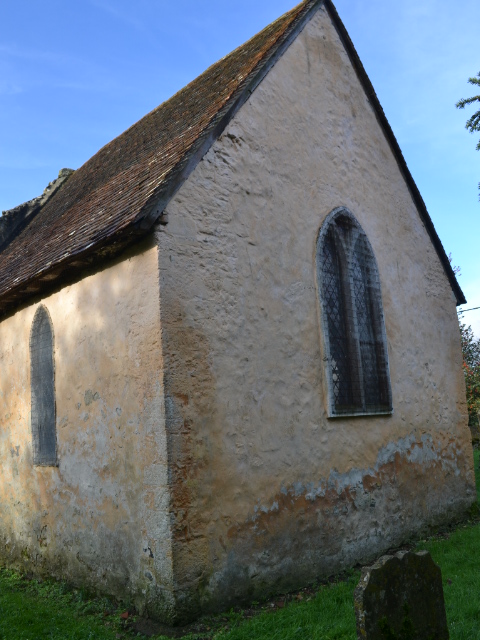The inappropriate installation of damp-proof courses to combat rising dampness accounts for much unnecessary work on old buildings. True rising damp is rarer than commonly perceived but is regularly misdiagnosed.
What is rising damp?
Rising damp is the upward movement of moisture through walls and sometimes floors by capillary action from below the ground. It can rise to 900 mm or more in walls, depending on the masonry type, water-table level and evaporation rate. Salt deposits generally form a horizontal tide-mark, below which there is discoloration. Floors can display moist patches and staining. Rising damp is distinct from other forms of damp, such as rain penetration and condensation, which require different solutions.
Greatham Old Church, Hampshire
Is rising damp common in old buildings?
Rising damp is commoner in old (pre-c1919) buildings than new ones but rarer than often supposed. Modern buildings keep water out with a system of barriers: damp-proof courses (DPCs) have been required in walls since 1875 and damp-proof membranes (DPMs) in floors from the 1960’s. Most old buildings lack these and therefore damp rises to some degree. This is usually not a problem where the construction can ‘breathe’, allowing evaporation, and may actually be advantageous in humidifying overly-dry centrally-heated buildings. Excessive damp arises where the moisture equilibrium is disturbed, as with misguided attempts to seal surfaces.
How is rising damp diagnosed?
Rising damp is widely misdiagnosed on the basis of high electrical moisture meter readings alone. Elevated readings occur not infrequently in old buildings that are virtually dry, due to salt deposition from evaporation, or can indicate another problem altogether, such as penetration from rainsplash. If rising damp exists, there will be visible indications too, such as an accompanying tide-mark, but not, for example, the external green staining symptomatic of rain penetration. High nitrate concentrations are likely. Tests to determine moisture levels within the wall thickness can help rule out surface condensation.
What if I believe a damp diagnosis to be wrong?
In the SPAB’s experience, mortgage lenders can demand unnecessary damp-proofing work during house purchases. Although chartered surveyors have a duty to follow a trail of suspicion, some simply pass all responsibility onto remedial treatment contractors with a vested commercial interest encouraging over-specification. It is worth challenging any recommendation you believe is questionable and, if necessary, seeking a second opinion in writing from an independent chartered surveyor or consultant (note, not contractor). The SPAB may be able to advise you on suitable names.
How can I control rising damp in an old building?
Measures that help the fabric ‘breathe’, such as replacing hard cement render or pointing with a more suitable lime-based mortar, may be the best solution. Conversely, applying water-proof renders and coatings can exacerbate damp problems. Where a floor has a DPM that is displacing moisture into the bottoms of walls, this might be replaced with a ‘breathable’ construction. Alternatively, a ‘breathing’ strip for evaporation may be cut through the floor around the room perimeter and infilled with a material such as lime concrete or grated over. Externally, ground works and improved drainage can assist.
Is a retrofit damp-proof course really necessary in old buildings?
There should be a presumption against retrospective DPCs, which, inappropriately installed in a pre-c1919 building, can be damaging, ineffective and an unnecessary expense. DPCs can have a role, though, perhaps where, say, irreversible alterations mean a building is effectively now functioning as a modern sealed structure. When selecting a DPC system and it is not feasible to insert a physical DPC, the SPAB suggests following BRE’s advice to consider only methods that have been awarded an Agrement or other third-party certificate. Chemical injection is the only method that currently satisfies this requirement. Physical and chemical DPCs, however, should be avoided in earth buildings, where major structural damage can result, and treatment is difficult in flint and rubble-cored walls.
What about plaster repairs on a previously damp old wall?
Lime plaster should normally be used for any repairs following work to combat rising damp. Salt-resistant plasters are favoured instead by many DPC installers but tend to just temporarily disguise continuing damp problems and may require listed building consent. A poultice of whiting and water is an old method of removing patches of residual salts from plasterwork. Decoration with paints such as limewash and soft distemper, where possible, will maximise ‘breathability’.
Further Reading
Burkinshaw, R and Parrett, M (2003) Diagnosing Damp, Coventry: RICS Business Services Ltd
Burkinshaw, R (2009) Remedying Damp, Coventry: RICS Business Services Ltd
English Heritage (2014) Building Environment, Practical Building Conservation, Farnham: Ashgate Publishing Ltd
Trotman, P, Sanders, C and Harrison, H (2004) Understanding Dampness: Effects, Causes, Diagnosis and Remedies, Garston: HIS BRE Press
Technical advice line
Get involved

